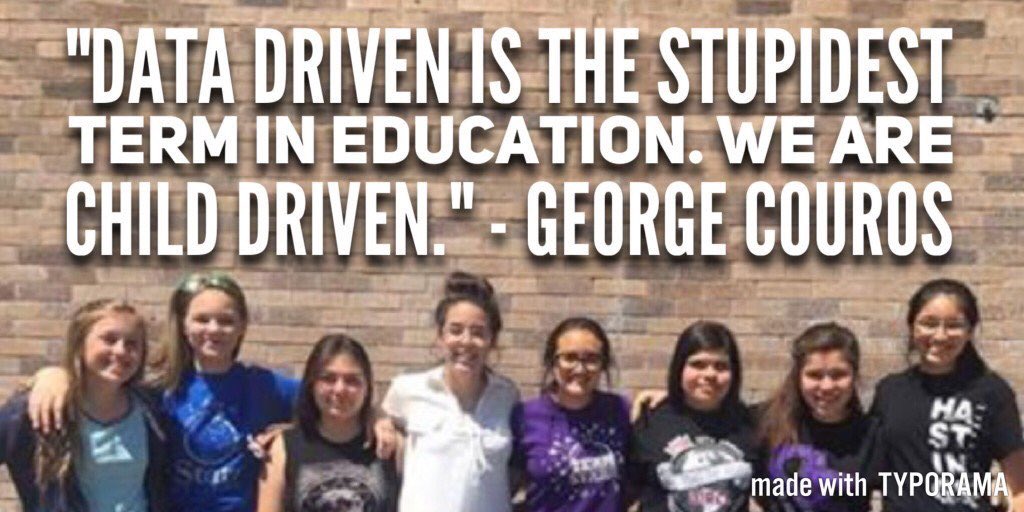It seems fitting that this quote from George Couros came across my Twitter feed this morning

It's no secret that I hate testing. I've written previously about my views on the damage that our incessant obsession with testing can wreak, and its effects on social studies education. I hate testing. But as I railed on about my issues with tests, I found myself asking if I was practicing what I'm preaching. Can I hate standardized tests, and then be ok with giving test after test in my own croom?
In the end, I felt like I was being hypocritical, and set my mind to exploring an alternative path to assessment. I still believe in assessing student knowledge, and I still think that mastery of content must be a goal. But does a test need to be the go-to option for that assessment? After exploring several approaches offered by my awesome PLN, and after talking extensively with a colleague of mine, I became intrigued with the idea of student choice for assessment. This is by no means a new idea, but I was excited to see how it might work in our croom.
In the end I developed something I call "demonstrated mastery." I like this term because I think it reflects the two purposes behind the effort. Student choice is reflected in the student choosing a method by which to "demonstrate" their "mastery" of the subjects we have covered in a unit. As I began to consider how this would work, I thought about a few key questions:
- Do I allow the students to simply come up with their own method, or do I offer them choices that I've developed?
- How do I ensure equity in the assessment? In other words, how do I assure that there isn't an "easy" option?
- Do I include a test as one of the options?
We just finished our first foray into this new approach, and here is how I set it up. I decided, in the end, to develop the choices myself. I began developing this effort a few weeks before we started through a conversation with the kids, and I could clearly see that they had never done this kind of thing before, thus I thought it might be easier to develop a set of choices and then present them to the kids. I decided to offer three choices- a written option, a creative option, and a test option. In the end I thought about the students in my classes, what they might want, and even thought about myself as a student. Ultimately I decided that there were, undoubtedly, at least some students who didn't mind a test, and felt like it had to be included as an option. The written option was connected to the "essential questions" around which our class is built. Nearly everything we do in class is connected to one of these questions; I tell the students that our goal is to be able to answer that question when we are done with our focus study. It made sense that we incorporate these into an assessment option in the form of a free-response. Finally, I have several students who are artistically-inclined and extremely creative and felt that there needed to be an option that would, perhaps, better serve them. For this round, the creative option was the creation of a newspaper.
Finally, I needed to consider equity in rigor; I didn't want the students to pick an option because it seemed like the "easy" option. Fortunately, these options presented a series of trade-offs; each requires work and preparation, but in different forms, and certainly with different payoffs. The test requires less in the way of production but requires actual studying and the hope that the information sticks when the test sits in front of you. The written option allows the student to explain their answer, but again requires preparation for an "in the moment" assessment. The creative option asks for more in the way of production, but students don't have to stress about producing the knowledge in a test environment. With a group of students who had not worked with this type of setup, the right choice was really hard, and we talked at length about the trade-offs for each option, and several of the students, surprisingly, initially chose the multiple choice option, but changed the following day to one of the other options. The division between the test and the written option was pretty even, with a spattering of students who chose the newspaper.
Following our trial run at this new assessment paradigm, I surveyed the students to gauge their feedback. Overall the feedback has been positive, with my favorite response being, "Not everyone learns and comprehends things the same; some people may not be as good at certain types of tests as others and I believe their perspective should also be valued. You shouldn't feed every zoo animal the same food." Moving forward I plan to use this strategy in the attempt to accommodate each student as much as possible, and I look forward to adding different choices.